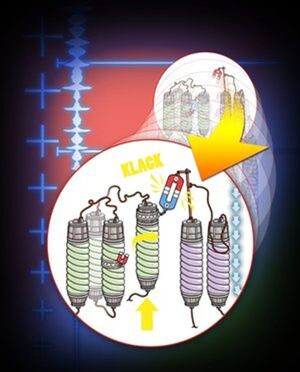Since voltage-gated sodium channels trigger action potentials, they are essentially responsible for the excitability of neurons. We investigate this channel and its physiological structure-function relationship as monomers and dimers.
Based on recently published CryoEM structures, we analyze the switching properties and altered pharmacology of sodium channel mutations in the context of cardiac arrhythmias, drug side effects, inflammatory neuropathies (including small fiber neuropathy), pain syndromes, as well as complex diseases such as schizophrenia or autism, as these can be associated with pathological variants or regulations of the chanal.
Peripheral neurons contain a variety of different subtypes of sodium channels. We also investigate their role in various sensory qualities within the Research Training Group MultiScale/MultiSenses.

Schematic representation of the opening of the sodium channel
The voltage-gated sodium channel Nav1.7 is significantly involved in the perception of potentially painful stimuli by peripheral neurons. Mutations of this channel may lead to pain syndromes, such as erythromelalgia. The erythromelalgia mutation Q875E creates a salt bridge within the channel molecule that stabilizes the voltage sensor of domain I in the activated position (metaphorically illustrated here by magnets).Thus, the Q875E mutation is likely to cause hyperexcitability and pain. This interaction between two chanal domains is probably the structural basis for a new mechanism underlying this pain disorder. Further information on this work can be found here and a graphical processing of our data can be found here.






